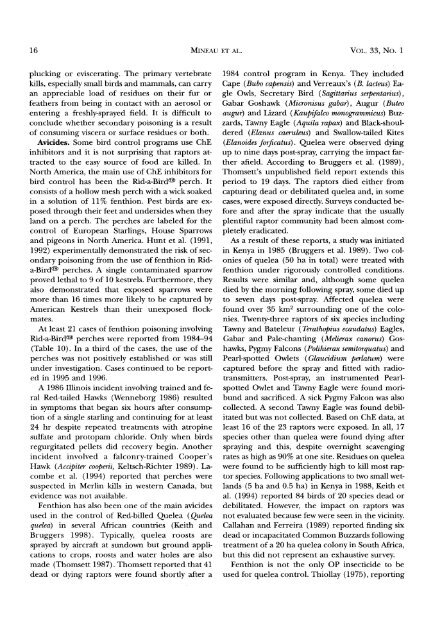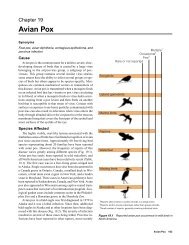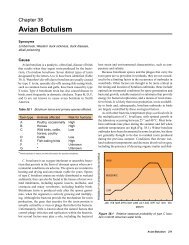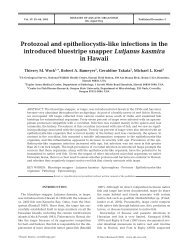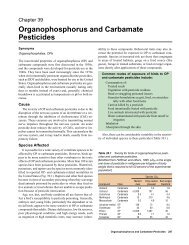poisoning of raptors with organophosphorus and carbamate ...
poisoning of raptors with organophosphorus and carbamate ...
poisoning of raptors with organophosphorus and carbamate ...
Create successful ePaper yourself
Turn your PDF publications into a flip-book with our unique Google optimized e-Paper software.
16 MINEAU ET AL. VOL. 33, No. 1<br />
plucking or eviscerating. The primary vertebrate<br />
kills, especially small birds <strong>and</strong> mammals, can carry<br />
an appreciable load <strong>of</strong> residues on their fur or<br />
feathers from being in contact <strong>with</strong> an aerosol or<br />
entering a freshly-sprayed field. It is difficult to<br />
conclude whether secondary <strong>poisoning</strong> is a result<br />
<strong>of</strong> consuming viscera or surface residues or both.<br />
Aviddes. Some bird control programs use ChE<br />
inhibitors <strong>and</strong> it is not surprising that <strong>raptors</strong> attracted<br />
to the easy source <strong>of</strong> food are killed. In<br />
North America, the main use <strong>of</strong> ChE inhibitors for<br />
bird control has been the Rid-a-Bird © perch. It<br />
consists <strong>of</strong> a hollow mesh perch <strong>with</strong> a wick soaked<br />
in a solution <strong>of</strong> 11% fenthion. Pest birds are ex-<br />
posed through their feet <strong>and</strong> undersides when they<br />
l<strong>and</strong> on a perch. The perches are labeled for the<br />
control <strong>of</strong> European Starlings, House Sparrows<br />
<strong>and</strong> pigeons in North America. Hunt et al. (1991,<br />
1992) experimentally demonstrated the risk <strong>of</strong> secondary<br />
<strong>poisoning</strong> from the use <strong>of</strong> fenthion in Rida-Bird•<br />
perches. A single contaminated sparrow<br />
proved lethal to 9 <strong>of</strong> 10 kestrels. Furthermore, they<br />
also demonstrated that exposed sparrows were<br />
more than 16 times more likely to be captured by<br />
American Kestrels than their unexposed flockmates.<br />
At least 21 cases <strong>of</strong> fenthion <strong>poisoning</strong> involving<br />
Rid-a-Bird © perches were reported from 1984-94<br />
(Table 10). In a third <strong>of</strong> the cases, the use <strong>of</strong> the<br />
perches was not positively established or was still<br />
under investigation. Cases continued to be reported<br />
in 1995 <strong>and</strong> 1996.<br />
A 1986 Illinois incident involving trained <strong>and</strong> feral<br />
Red-tailed Hawks (Wenneborg 1986) resulted<br />
in symptoms that began six hours after consumption<br />
<strong>of</strong> a single starling <strong>and</strong> continuing for at least<br />
24 hr despite repeated treatments <strong>with</strong> atropine<br />
sulfate <strong>and</strong> protopam chloride. Only when birds<br />
regurgitated pellets did recovery begin. Another<br />
incident involved a falconry-trained Cooper's<br />
Hawk (Accipiter cooperii, Keltsch-Richter 1989). Lacombe<br />
et al. (1994) reported that perches were<br />
suspected in Merlin kills in western Canada, but<br />
evidence was not available.<br />
Fenthion has also been one <strong>of</strong> the main avicides<br />
used in the control <strong>of</strong> Red-billed Quelea (Quelea<br />
quelea) in several African countries (Keith <strong>and</strong><br />
Bruggers 1998). Typically, quelea roosts are<br />
sprayed by aircraft at sundown but ground applications<br />
to crops, roosts <strong>and</strong> water holes are also<br />
made (Thomsett 1987). Thomsett reported that 41<br />
dead or dying <strong>raptors</strong> were found shortly after a<br />
1984 control program in Kenya. They included<br />
Cape (Bubo capensis) <strong>and</strong> Verreaux's (B. lacteus) Eagle<br />
Owls, Secretary Bird (Sagittarius serpentarius),<br />
Gabar Goshawk ( Micronisus gabar) , Augur ( Buteo<br />
augur) <strong>and</strong> Lizard ( Kaupifalco monogrammicus) Buzzards,<br />
Tawny Eagle (Aquila rapax) <strong>and</strong> Black-shouldered<br />
(Elanus caeruleus) <strong>and</strong> Swallow-tailed Kites<br />
(Elanoides forficatus). Quelea were observed dying<br />
up to nine days post-spray, carrying the impact farther<br />
afield. According to Bruggers et al. (1989),<br />
Thomsett's unpublished field report extends this<br />
period to 19 days. The <strong>raptors</strong> died either from<br />
capturing dead or debilitated quelea <strong>and</strong>, in some<br />
cases, were exposed directly. Surveys conducted before<br />
<strong>and</strong> after the spray indicate that the usually<br />
plentiful raptor community had been almost completely<br />
eradicated.<br />
As a result <strong>of</strong> these reports, a study was initiated<br />
in Kenya in 1985 (Bruggers et al. 1989). Two colonies<br />
<strong>of</strong> quelea (50 ha in total) were treated <strong>with</strong><br />
fenthion under rigorously controlled conditions.<br />
Results were similar <strong>and</strong>, although some quelea<br />
died by the morning following spray, some died up<br />
to seven days post-spray. Affected quelea were<br />
found over 35 km 2 surrounding one <strong>of</strong> the colo-<br />
nies. Twenty-three <strong>raptors</strong> <strong>of</strong> six species including<br />
Tawny <strong>and</strong> Bateleur (Terathopius ecaudatus) Eagles,<br />
Gabar <strong>and</strong> Pale-chanting (Melierax canorus) Goshawks,<br />
Pygmy Falcons (Polihierax semitorquatus) <strong>and</strong><br />
Pearl-spotted Owlets (Glauddium perlatum) were<br />
captured before the spray <strong>and</strong> fitted <strong>with</strong> radiotransmitters.<br />
Post-spray, an instrumented Pearlspotted<br />
Owlet <strong>and</strong> Tawny Eagle were found moribund<br />
<strong>and</strong> sacrificed. A sick Pygmy Falcon was also<br />
collected. A second Tawny Eagle was found debilitated<br />
but was not collected. Based on ChE data, at<br />
least 16 <strong>of</strong> the 23 <strong>raptors</strong> were exposed. In all, 17<br />
species other than quelea were found dying after<br />
spraying <strong>and</strong> this, despite overnight scavenging<br />
rates as high as 90% at one site. Residues on quelea<br />
were found to be sufficiently high to kill most raptor<br />
species. Following applications to two small wetl<strong>and</strong>s<br />
(5 ha <strong>and</strong> 0.5 ha) in Kenya in 1988, Keith et<br />
al. (1994) reported 84 birds <strong>of</strong> 20 species dead or<br />
debilitated. However, the impact on <strong>raptors</strong> was<br />
not evaluated because few were seen in the vicinity.<br />
Callahan <strong>and</strong> Ferreira (1989) reported finding six<br />
dead or incapacitated Common Buzzards following<br />
treatment <strong>of</strong> a 20 ha quelea colony in South Africa,<br />
but this did not represent an exhaustive survey.<br />
Fenthion is not the only OP insecticide to be<br />
used for quelea control. Thiollay (1975), reporting


